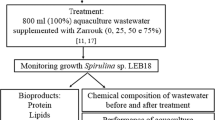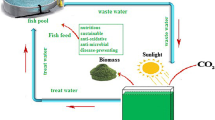Abstract
One application of biotechnology that contributes to sustainable development is the utilization of industrial byproducts as substrates for the production of substances of interest by microorganism. In this work, liquid effluent from tilapia fish processing was used as a substrate for the growth of Rubrivivax gelatinosus with the aim of studying the bacterial photo heterotrophic metabolism. Cultivation conditions included 32 ± 2°C, 1,400 ± 200 lux and 7 days. In the initial days, the best cell mass production (0.273 g l−1 with 72 h), specific growth rate (0.188 h−1 with 48 h) and chemical oxygen demand (COD) decrease (43% with 72 h) were reached. Typical bacterial oxycarotenoids were identified after 3 days of cultivation, averaging 3.03 mg g−1 biomass. Bacterial growth in the effluent during the period of study resulted in pH increase to 7.9, total nitrogen, oils and greases and COD decreases of 22.46, 47.71 and 52%, respectively, and dry cell mass production of 0.18 g l−1. The bacterial growth in the wastewater provided biomass and oxycarotenoids and the removal of pollutant load.



Similar content being viewed by others
References
APHA, AWWA and WPCF (2005) Standard methods for the examination of water and wastewater. American Public Health Association, Washington
Arvanitoyannis IS, Kassaveti A (2008) Fish industry waste: treatments, environmental impacts, current and potential uses. Int J Food Sci Tech 43:726–745
Ausich RL (1997) Commercial opportunities for carotenoid production by biotechnology. Pure Appl Chem 69:2169–2173
Azad SA, Vikineswary S, Ramachandran KB, Chong VC (2001) Growth and production of biomass of Rhodovulum sulfidophilum in sardine processing wastewater. Lett Appl Microbiol 33:264–268
Azad SA, Vikineswary S, Chong VC, Ramachandran KB (2003) Rhodovulum sulfidophilum in the treatment and utilization of sardine processing wastewater. Lett Appl Microbiol 38:13–18
Boscardin NR (2008) A produção aquícola brasileira. In: Ostrensky A, Borghetti AJR, Soto D (eds) Aqüicultura no Brasil: o desafio é crescer. Organização das Nações Unidas para Agricultura e Alimentação, Brasília, pp 27–73
Brasil (2005) Ministério do Meio Ambiente. Conselho Nacional do Meio Ambiente. CONAMA. Resolução no 357, de 17 de março de 2005. Dispõe sobre a classificação dos corpos de água e diretrizes ambientais para o seu enquadramento, bem como estabelece as condições e padrões de lançamento de efluentes e dá outras providências. Diário Oficial da República Federativa do Brasil, Brasília, 18 de março de 2005, 53:58–63
Breithaupt DE (2007) Modern application of xanthophylls in animal feeding: a review. Trends Food Sci Technol 18:501–506
Chiemchaisri C, Jaitrong L, Honda R, Fukushi K, Yamamoto K (2007) Photosynthetic bacteria pond system with infra-red transmitting filter for the treatment and recovery of organic carbon from industrial wastewater. Water Sci Technol 56:109–116
Eraso JM, Kaplan S (2001) Photoautotrophy. Encyclopedia of life sciences. Nature Publishing Group
Franco BDGM, Landgraf M (1996) Microbiologia dos alimentos. Atheneu, São Paulo
Giordano G (2004) Tratamento e controle de efluentes industriais. Departamento de Engenharia Sanitária e Meio Ambiente UERJ, Rio de Janeiro
Guerrero L, Omil F, Méndez R, Lema JM (1998) Protein recovery during the overall treatment of wastewaters from fish-meal factories. Bioresour Technol 63:221–229
Holt JG, Krieg NR, Sneath PHA, Staley JT (2000) Bergey’s manual of determinative bacteriology. Lippincott Williams & Wilkins, Philadelphia
Izu K, Nakajima F, Yamamoto K, Kurisu F (2001) Aeration conditions affecting growth of purple nonsulfur bacteria in an organic wastewater treatment process. Syst Appl Microbiol 24:294–302
Jirka AM, Carter MJ (1975) Micro semi-automated analysis of surface and wastewaters for chemical demand oxygen. Analyt Chem 47:1937
Kantachote D, Torpee S, Umsakul K (2005) The potential use of anoxygenic phototrophic bacteria for treating latex rubber sheet wastewater. Electr J Biotechnol 8:314–323
Liu SX (2007) Food and agricultural utilization and treatment. Blackwell, Ames
Maluping RP, Lavilla-Pitogo CR, Depaola A, Janda JM, Krovacek K, Greko C (2005) Antimicrobial susceptibility of Aeromonas spp., Vibrio spp. and Plesiomonas shigelloides isolated in the Philippines and Thailand. Inter J Antimicrobial Agent 25:348–350
Margalith PZ (1992) Pigment microbiology. Chapman & Hall, New York
Nogueira A (2007) Criação de tilápias em tanques-rede. SEBRAE, Salvador
Oda K, Tanskul S, Oyama H, Noparatnaraporn N (2004) Purification and characterization of alkaline serine proteinase from photosynthetic bacterium Rubrivivax gelatinosus KDDS1. Biosc Biotechnol Biochem 68:650–655
Ogawa M, Maia EL, Fernandes AC, Nunes ML, Oliveira MEB, Freitas ST (2007) Resíduos do beneficiamento do camarão cultivado: obtenção de pigmentos carotenóides. Ciênc Tecnol Aliment 27:786–792
Pereira CS, Possas CA, Viana CM, Rodrigues DP (2004) Aeromonas spp. e Pleisiomonas shigelloides isoladas a partir de mexilhões (Perna perna) in natura e pré-cozidos no Rio de Janeiro, RJ. Ciênc Tecnol Aliment 24:562–566
Ponsano EHG, Lacava PM, Pinto MF (2002) Isolation of Rhodocyclus gelatinosus from poultry slaughterhouse wastewater. Braz Arch Biol Technol 45:445–449
Ponsano EHG, Lacava PM, Pinto MF (2003) Chemical composition of Rhodocyclus gelatinosus biomass produced in poultry slaughterhouse wastewater. Braz Arch Biol Technol 46:143–147
Ponsano EHG, Pinto MF, Garcia Neto M, Lacava PM (2004a) Performance and color of broilers fed diets containing Rhodocyclus gelatinosus biomass. Braz J Poult Sci 6:237–242
Ponsano EHG, Pinto MF, Garcia Neto M, Lacava PM (2004b) Rhodocyclus gelatinosus biomass for egg yolk pigmentation. J Appl Poult Res 13:421–425
Ponsano EHG, Paulino CZ, Pinto MF (2008) Phototrophic growth of Rubrivivax gelatinosus in poultry slaughterhouse wastewater. Bioresour Technol 99:3836–3842
Prasertsan P, Choorit W, Suwanno S (1993) Optimization for growth of Rhodocyclus gelatinosus in seafood processing effluents. World J Microbiol Biotechnol 9:593–596
Prasertsan P, Jaturapornipipat M, Siripatana C (1997) Utilization and treatment of tuna condensate by photosyntetic bacteria. Pure Appl Chem 69:2439–2445
Sawayama S, Hanada S, Kamagata Y (2000) Isolation and characterization of phototrophic bacteria growing in lighted up flow anaerobic sludge blanket reactor. J Biosci Bioeng 89:396–399
Torres APC (2010) Biomassa bacteriana como aditivo de ração de aves e peixes. Dissertação, Universidade Estadual Paulista
Vieira RHSF (2003) Microbiologia, higiene e qualidade do pescado. Varela, São Paulo
Acknowledgments
Authors thank Fundação de Amparo à Pesquisa do Estado de São Paulo, FAPESP (process No 07/54732-1) for financial support and Tilapia do Brasil S/A Inc. for supplying the effluent.
Author information
Authors and Affiliations
Corresponding author
Rights and permissions
About this article
Cite this article
de Lima, L.K.F., Ponsano, E.H.G. & Pinto, M.F. Cultivation of Rubrivivax gelatinosus in fish industry effluent for depollution and biomass production. World J Microbiol Biotechnol 27, 2553–2558 (2011). https://doi.org/10.1007/s11274-011-0725-3
Received:
Accepted:
Published:
Issue Date:
DOI: https://doi.org/10.1007/s11274-011-0725-3




